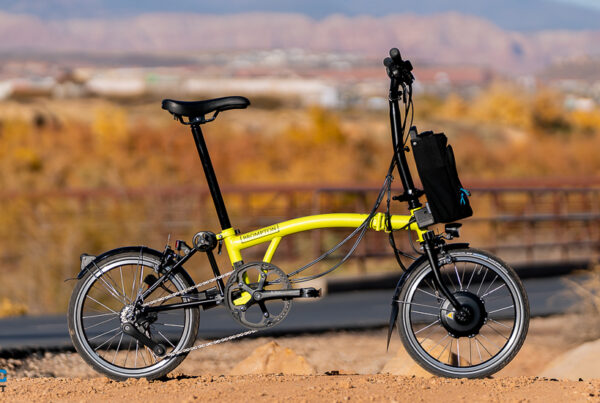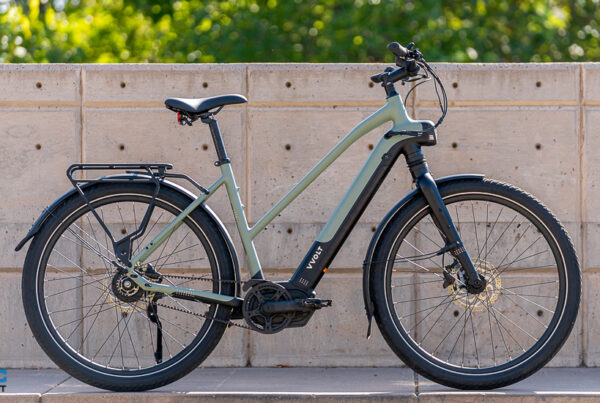Some links may be affiliate links. We may get paid if you buy something or take an action after clicking one of these.

Winter. A time when cold, snow and ice descends on much of North America, shorter days drive many indoors and most summertime toys get mothballed until warmer temps return.
But winter doesn’t have to keep you off your electric bike. You can absolutely ride your e-bike in winter, but there are some important things to keep in mind that’ll help keep you and your e-bike safe and functioning well until warmer days return.
Moisture and cold are the two most obvious considerations when riding your e-bike in winter. Both of these things could be detrimental to your bike and its electrical componentry, but many e-bikes on the market today are actually designed to handle these conditions.

A rider on the Diamondback Response e-bike navigating a cold and wet day.
Fat bikes for example, the plus-sized SUV’s of the e-bike world that have grown so popular in recent years, were actually initially developed specifically for winter riding. The wider tires provide good floatation in snow and the larger contact patch gives solid traction in slippery conditions. Many e-bikes are even designed to be water resistant, which helps shield the more sensitive electrical parts from the wet — frozen and otherwise — that’s so prevalent during winter in many parts of the country.
But aside from e-bike design, there are several things you can do as a rider and owner of an e-bike to safeguard your bike from winter hardship.
Tips for winter e-bike riding
Admittedly, winter is prime riding season in Electric Bike Report’s home base of southern Utah — as it is for much of the American southwest. But that doesn’t mean we’re not well-versed in the art of winter riding.
It still gets very cold here and our locale is not immune to the occasional mid-winter snowstorm, so even us desert dwellers need to employ some basic winter riding principals. But in colder and less arid parts of the country, dealing with cold, snow and ice is just part of the yearly riding routine.
For those who refuse who let Old Man Winter sully their e-bike rides, here’s a few best practices to get you through:
Store your battery inside and keep your e-bike protected from the elements

Riding in the snow is always an option — if you’re prepared.
Batteries do not like extreme temperatures, cold included.
According to Bosch, low temperatures can cause a battery to lose capacity and thus limit your bike’s range. In extreme cold — think temperatures near or below zero — it’s best to remove your battery from the bike and store it at room temperature, only putting it back on the bike just before you’re ready to ride. Batteries should also be charged at room temperature to avoid damage to the cells; it’s even advised to wait to begin charging a battery after a cold ride until it has re-warmed to room temperature.
Your bike itself should handle storage in a cold environment fine, but it’s heavily encouraged that you take steps to protect it from the elements. Garages or sheds are great locations, but you can also get away with storing your bike outside — just make sure it’s covered from precipitation.
Clean your e-bike regularly
Just like a car, rust and corrosion from witnertime use can be an issue with e-bikes.
Road salt and other anti-icing agents can be particularly hard on e-bikes and their components, so do your best to wipe down and clean your e-bike if your area sprays roads in the wintertime. That includes the frame and drivetrain as well as the electrical components.
Spray from wet roads can also kick dirt and grime into your chain and gears, so take steps to clean and lubricate those components after every ride. Wintertime riding
Get the right tires for slick, cold conditions
When it comes to keeping the rubber side down during colder — and potentially slicker — months, tire choice is key.
As we mentioned before, electric fat bikes have a natural leg up in the tire department. Their typically 4-inch or wider tires were initially developed for floatation in snow and traction on slick, so they’re naturally well suited for winter riding. Other tire types, however, especially the semi-slick tires popular on many electric commuter bikes, might struggle for traction in snow.
Be conscious of the type of tire your e-bike has before venturing into inclement winter weather or onto roads that might be frozen. Wider, more treaded tires are going to be conducive for winter conditions and several tire brands even make studded tires or tires with special cold weather rubber compounds.
Be wary of hazards, layer up and take your time
Lastly, winter riding just poses a whole host of new hazards you don’t normally encounter in warmer months. These hazards range from slick surfaces to unpredictable weather and drivers who may be less expectant to see cyclists in bike lanes.
Wintertime riding is conducive to planning and preparedness. Make sure you’ve got the layers to stay warm if you’re caught out in weather you don’t expect, lights are a good idea for the shorter days and put fenders on your bike if you can. But perhaps most importantly, is just being attentive to the obstacles in your immediate path. Keep an eye out for the sheen of black ice and just slow down a little before corners.
Sponsors
Related
Reader Interactions
![]()
Source link








